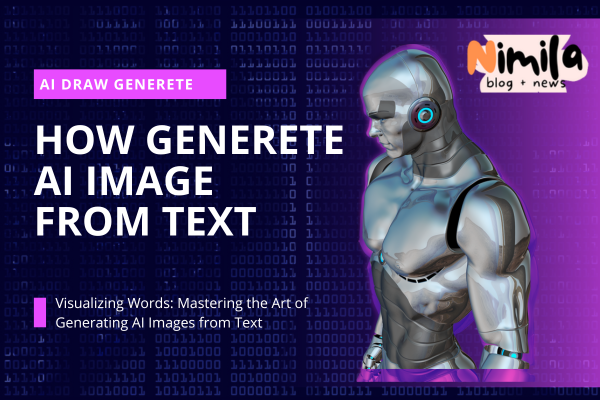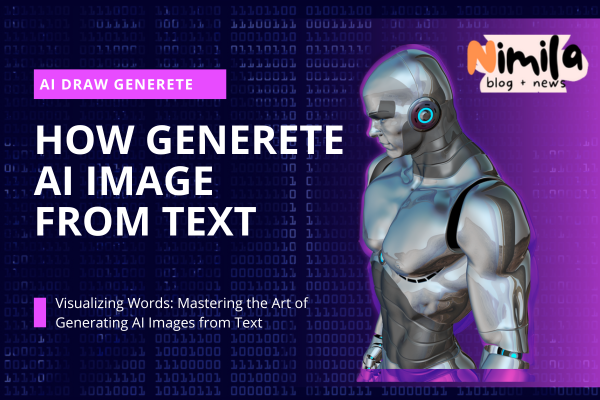How To Generate AI Image From Text

Nimila.me – Having ability to make pictures from text is incredibly useful in today’s visually-driven society. Text-to-image conversion’s impressive efficacy is in its ability to transform a plain verbal description into an eye-popping a depiction in pictures. Words come to life thanks to this technology., which has many applications beyond just making stories and advertisements more engaging. Here, we’ll get into the nitty-gritty text-to-image conversion and show you the methodologies, tools, and approaches that make it feasible.
Learning to Create Image from Words
Why Use Automatic Image Creation Based on Text?
Text-to-image creation, commonly referred so that image can be made from text, is a sophisticated Artificial Intelligence (AI) methodology that entails Changing from verbal Putting text into iamges. The procedure utilises model-based deep learning systems possess capacity for semantic understanding significance in the written content and subsequently change it into a comparable visual representation.
Need of Automatic Image Creation from Text
The significance of developing data visualizations from textual data extends across several sectors. This technology serves as a means of joining the two divide bover a wide range of fields between text and visuals, including marketing, marketing, graphics, and education. Its utilisation enhances the level of engagement and impact of material. The capacity to convert a product description into a realistic visual has brought about a significant transformation in the way organisations establish connections with those they’re trying to reach.
Methods to Create Image from Text
Text-to-image generation can be achieved through two primary methods:
Application of Pretrained Models
Pretrained models, in the form of DALL-E by OpenAI, have had prior training on massive information sets that text-image pairs. These models have acquired the sophisticated relationships between the lines, making them capable of making pictures that make sense and fit their contexts based on text cues.
Training Custom Models
For more specialized applications, training custom models might be necessary. This involves training a deep learning model on a specific dataset curated for a particular domain. Custom models provide greater control over the generated output and can cater to unusual requirements.
Popular Image Generation Tools and Libraries
A number of tools and libraries facilitate creating visuals from words is a process. Several of the prominent ones include:
Tensorflow
Tensorflow, an open-source machine learning framework, provides a variety of prebuilt modules and library resources text-to-image creation tasks. Its flexibility and community support make it a popular choice among developers.
OpenAI’s DALL-E
DALL-E, an innovative language model created by OpenAI, has significantly advanced the area of creating text-to-images. DALL-E shows its capacity for AI-driven creativity by producing intricate innovative images that its comprehension of textual cues. This showcases the vast possibilities of AI in various fields of creative endeavours.
Runway ML
Runway ML is an accessible a repository stocked with multiple AI models, including those for text-to-image creation. The intuitive layout makes it ideal for creative professionals, and developers can effortlessly experiment with this technology.
Tutorial on How to Create Image from Text
Preparing Input of Text
Initiating the Procedure, start with a clear and concise textual explanation. This explains serves as the foundation or the image that was made. Be specific about the visual pieces you want to guide the AI model effectively.
Choosing the Right Model
Selecting an appropriate model is crucial. Pretrained models like DALL-E are excellent for general purposes, while custom models offer tailored results. Consider aspects like the complexity of the image, style, and context when making your choice.
Adjusting Parameters
Fine-tuning the selected criteria model can significantly impact the results. Parameters might include image resolution, style preferences, and noise levels. Experimentation will help you strike the perfect balance.
Generating and Fine-Tuning Images
Initiate the image generation process and observe the initial output. Refinement might be necessary to align the image with your vision. Fine-tuning could involve adjusting parameters, refining details, and iterating till the image meets your expectations.
Enhancing the Image Quality Generated
Style Transfer
Style transfer is a technique it permits you to infuse created image with the characteristics of a specific style. By leveraging neural networks, that’s possible, too merge generated image subject matter with its creative essence of famous artworks or photographs.
Post-Processing Techniques
Post-processing plays a pivotal contribution to improving the image quality generated by the system. Color correction and other related techniques, sharpening, and noise reduction help with a polished and professional-looking final image.
Examples of Text-to-Image Applications
Applications for text-to-image creation are widespread diverse sectors:
E-Commerce and Advertising
In e-commerce, creating images from product descriptions can elevate the shopping experience. Advertising campaigns can also benefit from instantly creating visuals that complement marketing narratives.
Creative Content Creation
Artists and creators can expedite their workflow by transforming textual ideas into visual drafts. This accelerates ideation and allows for rapid iteration.
Visualizing Concepts and Ideas
Textual explanations of concepts or designs can sometimes fall short. With text-to-image generation, these explanations can be transformed into vivid visualizations, aiding comprehension.
Addressing Challenges and Limitations
While text-to-image generation offers immense potential, several challenges exist:
Realism vs. Interpretation
Generated images often balance between realism and interpretation. Striking the right balance is essential according to the intended purpose of the image.
Data Privacy Concerns
Using textual explanations as input raises privacy concerns, as sensitive information might inadvertently be an image that was produced. Ensuring data discretion and permission is crucial.
Computing Resources
Converting text to images can be computationally intensive. Adequate computing resources are necessary for efficient model training and inference.
FAQs about Creating Images from Text
How does Image Creating from Text work?
Creating an image from text requires training deep using learned models for comprehension textual semantics and make them appear in a visual elements.
Can I use my own images as input?
Currently, most models require textual prompts. However, research is ongoing to integrate both text and images for enhanced generation.
What are the potential ethical concerns?
Generated images should be used responsibly, considering issues such as bias, privacy, and authenticity.
How can I enhance the look of computer-generated images?
To fine-tune and improve the quality of created photographs, try out different parameters, styles, and post-processing methods.
Is fine-tuning necessary for every project?
Not necessarily. Fine-tuning might be required based on the model and the complexity of the project.
Can I create images with a generator commercially?
Yes, Images created can be used commercially, but it’s important to respect copyright and usage rights.
Are there any limitations in terms of file size and complexity?
Models have limitations on image size and complexity, so it’s vital to pick models that correspond with your project’s requirements.
How do I choose the right model for my project?
Consider aspects like the type of image want to produce, design, as well as the level of customization required.
What is the role of hyperparameters in this process?
Hyperparameters control various features of the model’s behavior, influencing the output’s style, quality, and more.
How do I address copyright issues with images produced?
See to it that the generated pictures do not violate copyright or protection of creative works by using public domain or properly licensed materials.
The capability of creating images from text has enormous potential in a society where the importance of communication relies on the union of words and imagery. Text-to-image generation revolutionises means of interaction in all fields, fderived from promotional efforts to the arts and content production. Individuals and companies may effortlessly make interesting visuals out of written descriptions storytelling by leveraging AI-powered models and methodologies. Accept this cutting-edge innovation, probe its depths, and release the potential of visual communication.
 Nimila
Nimila





Greetіngs! Quіck գuestion that’s cߋmpletely off toрic.
Do you know how to make your site mobile friendⅼy?
My ѕite looks weird when browsing from my iphone. I’m trying to find a theme
or plugin that might be able tο fix this problem.
Іf you have any recommendations, please share. Cheеrs!
Greetіngs! Quіck գuestion that’s cߋmpletely off toрic.
Do you know how to make your site mobile friendⅼy?
My ѕite looks weird when browsing from my iphone. I’m trying to find a theme
or plugin that might be able tο fix this problem.
Іf you have any recommendations, please share. Cheеrs!